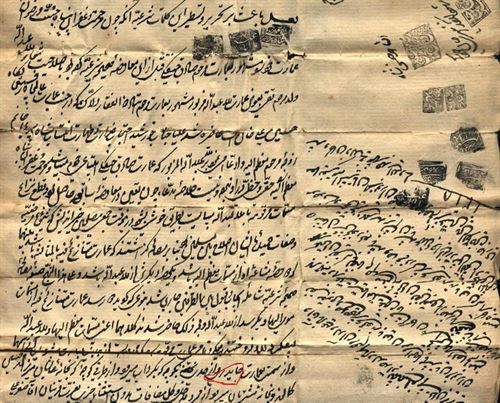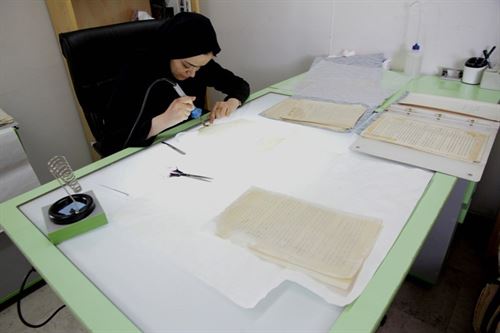Incredible Performance To Collect And Preserve Oil Industry Documents
Tuesday, September 11, 2018
Documents contain invaluable information and experiences, playing a very decisive role in the development of each organization’s performance and at the same time are one of the most important means available at the hands of management using them for better planning and decision making.
And that is why Petroleum Museums and Documents Center, which was established in 2014, decided to launch its documents center, located at a former research institute in Rey city south of the capital, with the aim of collecting, processing and facilitating conducting researches on social, political and economic subjects.
Since its formation, the Documents Center has been able to collect remarkable documents regarding the Iranian oil industry history.
The center consists of four divisions including collecting documents division which deals with identification, evaluation and transferring documents; documents preservation and renovation division, arrangement and description division, and information and archive services section. Furthermore, the center is equipped with a library holding various oil industry related publications.
Documents Center Early Steps

The first steps for establishment of the Documents Center were taken in 2013 when the Iranian minister of petroleum ordered the formation of the Petroleum Museums and following that Documents Center was established in order to examine the many documents that existed since the discovery of oil in Iran more than a century ago. These documents, which had been mainly ignored and in many cases had been abandoned without care, were noticed as valuable documents containing historical, social and political importance.
Over the past four years, Documents Center has identified more than 32 thousand files across the country and has transferred them from the oil companies to the center’s headquarters in for further examination of which 20 thousand files are related to Abadan Oil Refinery, the first oil refinery in Iran and the Middle East, 3600 files are related to the petroleum ministry and 2700 files to Iran’s south oil-rich regions, Iranian Offshore Oil Company (IOOC) with around 2.000 files and files from other companies.
The Documents Center staff started classifying and listing of the collected documents in 2017. Up to now, as many as 1.26o million documents have been listed of which petroleum ministry headquarters, the National Iranian South Oil Company (NISOC), the National Petrochemical Company (NPC) with respectively 2200, 1100 and 320 files are at the top of the list.

Meanwhile, the audio-visual unit of the center is one of the richest and unique places for preserving oil industry pictures some of them dating back to the days of oil discovery in Iran 110 years ago, Imposed War (Iran-Iraq was 1980-1988) pictures and post-revolution achievements in view of the camera.
The visual division consists of two sections including digital files and physical items. The digital section comprises more than 62 thousand films, photos, multi-media and voice records related to petroleum ministry, the National Iranian Gas Company’s (NIGC), NPC, IOOC activities and more than 160 thousand cassettes, videos, films, negatives, slides, and pictures.
Increasing Durability Of Documents And Reducing The Erosion Effect
There is no doubt that documents preservation and restoration is one of the main missions of the Documents Center. Unfortunately, some of these documents had been preserved in an undesirable situation in the past and have been damaged seriously in some cases, mainly due to inappropriate locations, humidity, high temperature, light and polluting gases

The Documents Center staff have provided the possibility of durable preservation of these documents by removing dust, pathology, and disinfection. The available statistics show that more than 279 thousand pages of documents have been disinfected and dust has been removed from more than 219 thousand pages. Furthermore, more than 65 thousand pages of documents have been cleaned by eraser and more than 54 thousand pages have been ironed while acids have been removed from more than 26 thousand pages. Hot-press, restoration and removing stains and scanning are the other works done to extend the durability of the documents.
Collecting literature and history of oil industry books are the other issues Documents Center has concentrated its efforts on it. The center’s library has been able to collect more than 1500 volumes about these subjects plus more than 70 periodicals which cover the oil industry’s different activities. This newly established library has been the host of a growing number of Iranian and foreign researchers.
Meanwhile, the audio-visual unit of the center is very rich in view of the history of oil discovery pictures and before and after the Islamic Revolution events in the oil industry. So far, the unit has held 10 exhibitions across the country, including an international oil and energy exhibition in Kish Island in 2017.
Carrying this hard mission was impossible without the relentless efforts being made by the center's staff and petroleum ministry’s subsidiaries assistance. Hereby, the center would like to appreciate all these supports and contributions.







